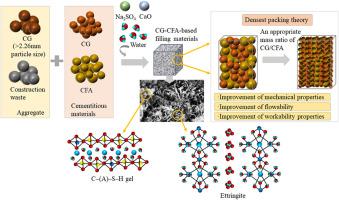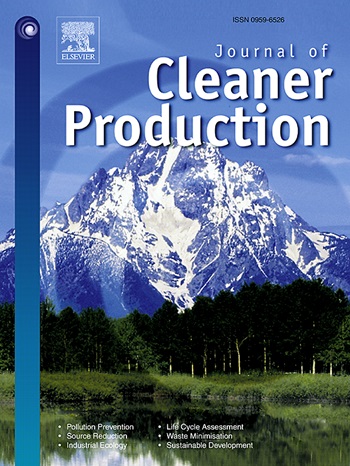The influence of coal gangue dosage and concentration on the properties and hydration mechanism of fly ash-based cemented filling materials
IF 9.7
1区 环境科学与生态学
Q1 ENGINEERING, ENVIRONMENTAL
引用次数: 0
Abstract
Coal gangue (CG) and coal fly ash (CFA) synergistic utilization for preparing CG-CFA-based filling materials (CCFM) aligns with the sustainable development of mining operations. However, systematic performance characterization tests and in-depth studies of hydration mechanisms remain insufficient. This study investigated the effects of CG content and slurry concentration on the mechanical properties, flowability, workability, and hydration mechanisms of CCFM. Single-factor experiments identified the optimal mix (JS5) with a CG-to-CFA mass ratio of 40:60, a >2.26 mm CG-to-construction waste mass ratio of 1:1, a binder-sand ratio of 0.2, and a concentration of 70%. This formulation achieved compressive and flexural strengths of 13.17 MPa and 6.78 MPa, respectively, at 28 days. An appropriate amount of CG reduced particle frictional shear stress (yield stress τ0 = 0.1668 Pa), improved slurry diffusibility, and minimized settlement shrinkage and bleeding rates, and exhibited lower settlement shrinkage and bleeding rates. Low slurry concentration significantly reduced compressive strength, flexural strength, and yield stress. Environmental safety testing revealed that CCFM posed no heavy metal leaching risk. Hydration mechanism analysis indicated that the appropriate addition of CG increased cumulative heat release (750.96 J/g), hydration rate (t50 = 372.73 h), and hydration degree (α = 31.37%) in JS5, enhancing the dissolution of active [SiO4]4– and [AlO4]5– substances and raised the six-coordinated [AlO6] content in ettringite (83.61%), and improved the bridging oxygen bond content in C–(A)–S–H gel (82.78%). These changes also increased the average grayscale value (101.41) and structural compactness of CCFM. These findings provide valuable insights into CG and CFA utilization, offering theoretical support for developing high-properties CCFM.


求助全文
约1分钟内获得全文
求助全文
来源期刊

Journal of Cleaner Production
环境科学-工程:环境
CiteScore
20.40
自引率
9.00%
发文量
4720
审稿时长
111 days
期刊介绍:
The Journal of Cleaner Production is an international, transdisciplinary journal that addresses and discusses theoretical and practical Cleaner Production, Environmental, and Sustainability issues. It aims to help societies become more sustainable by focusing on the concept of 'Cleaner Production', which aims at preventing waste production and increasing efficiencies in energy, water, resources, and human capital use. The journal serves as a platform for corporations, governments, education institutions, regions, and societies to engage in discussions and research related to Cleaner Production, environmental, and sustainability practices.
 求助内容:
求助内容: 应助结果提醒方式:
应助结果提醒方式:


